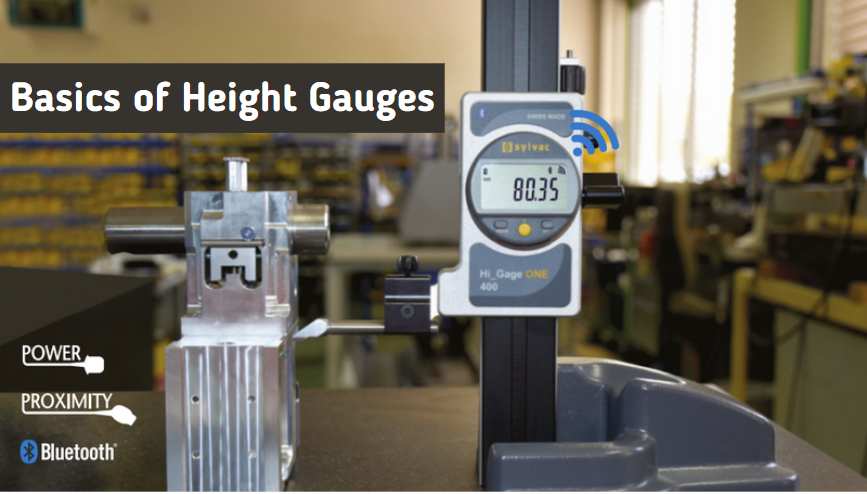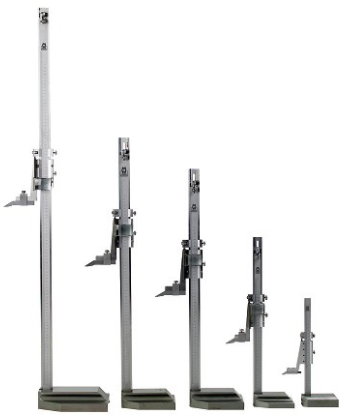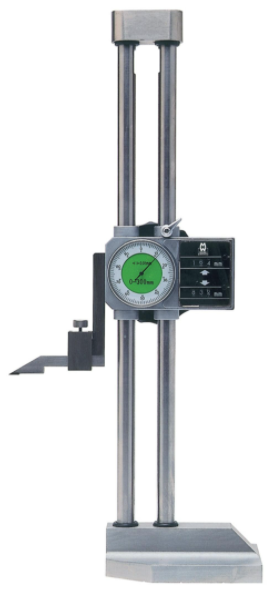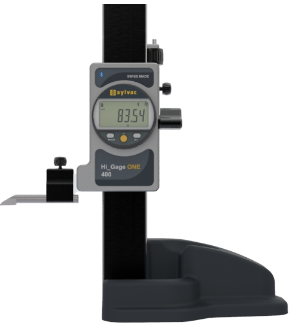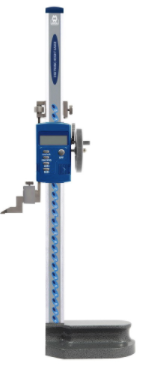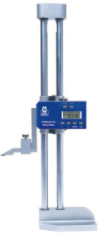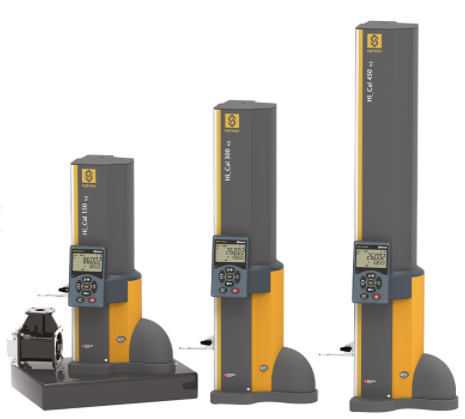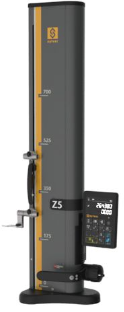What is a height gauge and how does it work
Precision and accuracy is king in the world of Metrology; the scientific study of measurement. In manufacturing, Metrology plays a large role in Quality Control (QC) to ensure that all workpieces produced are able meet their specification requirements. This makes benchtop tools such as height gauges a staple in the workroom. Compared to Coordinate Measuring Machines which can perform similar functions, height gauges are a more cost effective option when wanting to conduct quality checks on smaller and more intricate parts.
As its name suggests, height gauges are primarily used to measure heights or mark a certain height on the workpiece but they can do so much more. Each height gauge is equipped with a scriber or probe that is held by a measuring jaw and slider that lies parallel to the reference surface. The slider moves along a vertical measuring scale held perpendicular to the base of the height gauge.
Benefits
1. Wide range of functions for use in different situations
Although there are many different models of height gauges on the market, similarities lie in the basic functions which are to measure the heights of workpieces. What sets each height gauge apart is the additional functions and abilities beyond measuring heights that are tailored to specific applications. For example, height gauges can also be used to measure flatness and squareness of workpiece parts. Depending on your individual needs, there is a height gauge out there just for you.
2. High levels of precision and specifications that reduces inspection
For a height gauge to be effective, it must have good precision and resolution. Especially in digital models that are pricier, high levels of precision (also known as repeatability) can be achieved to ensure that all workpieces are tested under the same if not highly similar conditions. Furthermore, the measuring force applied to the workpiece tested should also be constant to generate consistent readings. Having consistent measuring conditions will allow operators to spend less time on checking for the presence of anomalies, leading to greater levels of efficiency.
3. Electronic and wireless capabilities
With the advancements in technology, devices are constantly being fitted with electronic and wireless capabilities and the height gauge is no exception. These capabilities provide users with the ease of reading with clarity and precision. Some models of height gauges are also able to store data from readings and connect directly to the floor network, aiding in the record keeping and statistical analysis process.
Looking for a height gauge? Click here for Sylvac's Best Sellers Promotion 2021
Types of height gauges
There are four main categories of height gauges:
1. Vernier height gauge
Of the four types of height gauges in the market, the vernier height gauge is the most basic and earliest height gauge created. It was first adapted from vernier calipers to measure vertically, hence why the vernier scale slides along a vertical main scale. Vernier height gauges are most commonly available in measuring sizes that range from 6 inches to 6 feet and their scales are either in inches, millimeters (mm) or both.
Moore & Wright Vernier Height Gauge 190 Series
The Moore & Wright Vernier Height Gauge 190 Series is a sturdy and well-made vernier height gauge with a high quality hardened stainless steel beam and a chrome plated scale. The height gauge also features an adjustable zero reference point for calibration as well as a magnifying glass to assist in the reading of the vernier scale. Additionally, the measuring faces undergo a process called micro-lapping which smooths the surface, ensuring that measurements can be taken with a higher degree of accuracy. With a resolution of 0.02 mm, the Moore & Wright Vernier Height Gauge 190 Series comes in a few measuring sizes that go up to 24 inches (0 - 600 mm).
2. Dial height gauge
Compared to vernier height gauges, dial height gauges have smaller measuring size ranges, usually measuring less than 12 inches in height (300 mm). Equipped with a mechanical dial, the needle pointer provides operators with ease and clarity in reading the measurement data. As dial height gauges are used to measure smaller workpieces, they tend to be smaller and more portable as well.
Moore & Wright Double Column Height Gauge 195 Series
The Moore & Wright Double Column Height Gauge 195 Series features dual directional mechanical counters as well as a dial indicator for fast measurements with high accuracy. The mechanical digital counters can also be set to zero at any position to cater according to your needs. A hand feed wheel is also provided for easy up and down feeding along the double column that gives additional stability. The counter of the Moore & Wright Double Column Height Gauge 195 Series will read steps of 1 mm with a resolution of 0.01 mm for both measuring range sizes available(300 mm and 600 mm).
3. Digital counter height gauge
A digital counter height gauge is similar to a dial height gauge, but has an added counter feature for more precise measurement. This dual-digit counter will increase the accuracy of readings with the counter reading to a tenth of an inch and the dial reading to a thousandth of an inch. Having the additional counter will also allow for an absolute and floating zero to be set by the operator if needed.
4. Electronic digital height gauge
The electronic height gauge features a digital display with measurements in inches or millimeters instead of analog dials and mechanical counters. Of the four categories of height gauges, the electronic digital height gauge boasts having the most features to improve the user experience and the measuring accuracy. One common additional feature would be data storage and output capabilities through a USB or RS232 port, or even through wireless BluetoothⓇ connectivity.
Looking for a height gauge? Click here for Sylvac's Best Sellers Promotion 2021
There are 2 types of electronic digital height gauge. The first type are those that come with a motorized Z-axis travel. The second type has manual Z-axis travel.
Sylvac Digital Height Gauge Hi_Gauge ONE
In comparison, the Sylvac Digital Height Gauge Hi_Gauge ONE is a basic model with manual travel that performs simple functions such as measuring internal and external diameters. Although the device lacks wireless BluetoothⓇ connectivity and only has USB and RS232 output capabilities, it offers two versions with slightly larger measuring range sizes, one at 400 mm and the other at 600 mm. With a resolution of 0.01mm and repeatability of 10 µm, the Sylvac Digital Height Gauge Hi_Gauge ONE offers great efficiency by eliminating the need for hands-on probe interpolation required for vernier height gauges.
Moore & Wright Digital Height Gauge 193 Series
Other simpler models like the Moore & Wright Height Gauge 193 Series, features an easy to read LCD Display and is available in two measuring range sizes, 300 mm and 600 mm. Its measuring surfaces are also ground and micro-lapped to ensure the precision and accuracy of the measurements taken. The device also has a handwheel operation with a positive lock mechanism to ensure safety when measuring workpieces. With both a repeatability and resolution of 0.01 mm, you can be assured that measurement readings will be taken with accuracy with its carbide tipped scriber.
Moore & Wright Digitronic Double Column Height Gauge 195 Series
The Moore & Wright Digitronic Double Column Height Gauge 195 Series is another example of a digital height gauge. Having a double column combines high stability with absolute accuracy and the hand feed wheel provides for easy up and down feeding. This height gauge also features a large 7.5 mm tall digital display for easy reading. With a resolution of 0.01 mm, the Moore & Wright Digitronic Double Column Height Gauge 195 Series has two measuring sizes, one at 12 inches (0 - 300 mm) and one that goes up to 24 inches (0 - 600mm).
Sylvac Height Gauge Hi_Cal V2 SMART
With a repeatability of up to 2 µm, the Sylvac Digital Height Gauge Hi_Cal V2 SMART comes with the ergonomic motorized displacement paddle. It is slightly more advanced and allows operators to unlock higher levels of precision and accuracy. Available in three ranges; 150, 300 and 450 mm, the device can measure internal and external diameters, heights, thicknesses and more. As it is a digital height gauge, there is no operator influence on the measurement result as well. The Sylvac Digital Height Gauge Hi_CalV2 SMART also offers great mobility and battery life despite it being a portable lightweight model. Additionally, this device has USB, RS232 and wireless BluetoothⓇ connectivity output capabilities.
Sylvac Digital Height Gauge Z5
Another model under the Sylvac brand would be the Sylvac Digital Height Gauge Z5 with both USB and RS232 output connectivity capabilities for easy recording and transmission of measurement data to any device. This height gauge also has extendable capabilities that make this height gauge one of the tallest height gauges in the market (700 mm measuring range size can be extended to 1023 mm). With a repeatability of 2 µm, the Sylvac Digital Height Gauge Z5 provides repetitive accuracy for top levels of precision in various applications.
If you are looking for a height gauge or wish to find out more, feel free to contact us for a consultation.
Click on the following keywords to read more about the Digital Transformation in Measurement, Basics of Bore Gauges and Sylvac's Bestsellers Sale.
References:
Metrology - Wikipedia. (2021). Retrieved 11 May 2021, from https://en.wikipedia.org/wiki/Metrology#:~:text=Metrology%20is%20defined%20by%20the,field%20of%20science%20and%20technology%22.
Coordinate-measuring machine - Wikipedia. (2021). Retrieved 11 May 2021, from https://en.wikipedia.org/wiki/Coordinate-measuring_machine
Sullivan, P., & Grosenbach, M. (2018). Retrieved 11 May 2021, from https://www.qualitymag.com/articles/94548-new-heights-in-height-gages
Edwards, E. All About Height Gauges - Definition, Sizes, and Uses. Retrieved 11 May 2021, from https://www.thomasnet.com/articles/instruments-controls/all-about-height-gauges/
What Are the Advantages of Using A Digital Height Gauge? – Ratahan. (2020). Retrieved 11 May 2021, from https://ratahan.com/advantages-of-digital-height-gauge/
Hemand, P. Advantages of Using a Height Gauge. Retrieved 11 May 2021, from https://testingmeasuringinstruments.wordpress.com/2019/08/16/height-gauge-advantages/
Lapping - Wikipedia. (2021). Retrieved 11 May 2021, from https://en.wikipedia.org/wiki/Lapping
Smith, K. (2021). Quality Digest Magazine. Retrieved 11 May 2021, from https://www.qualitydigest.com/sept02/articles/01_article.shtml

